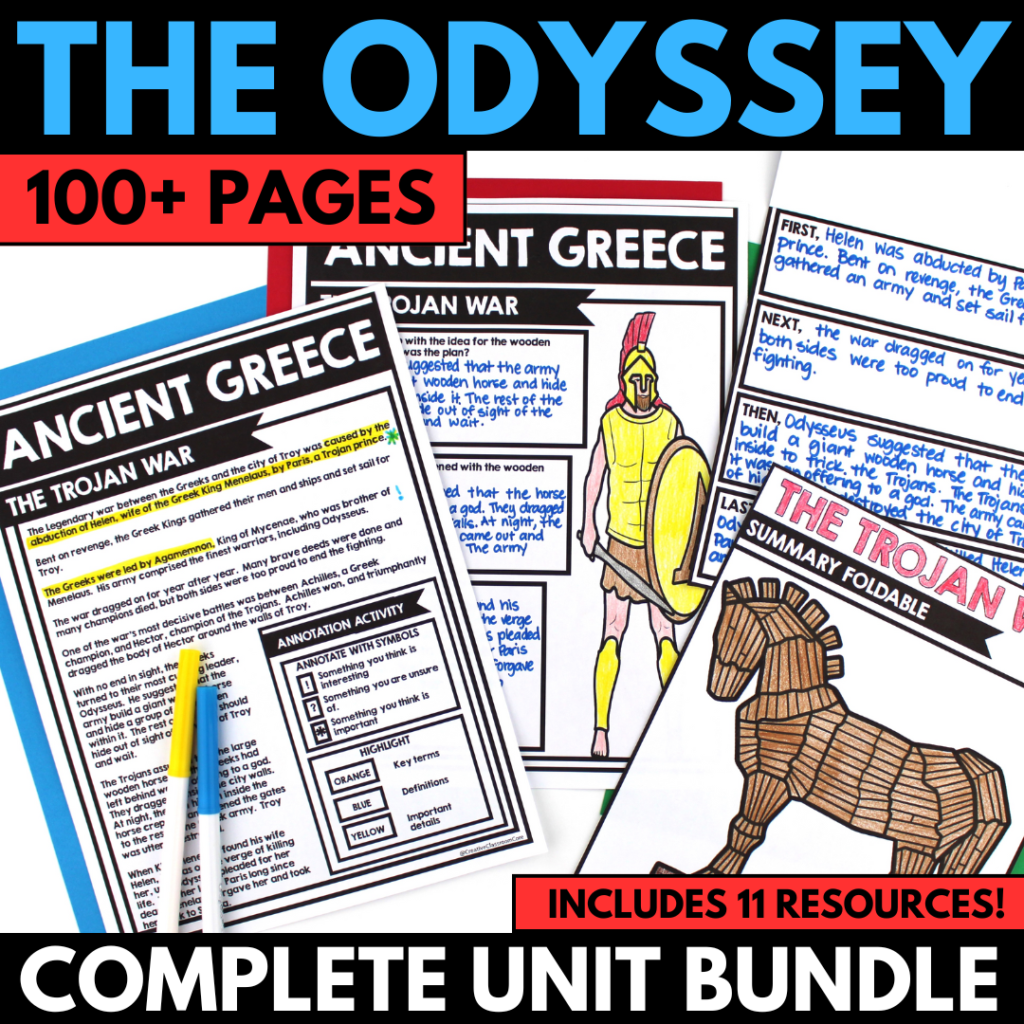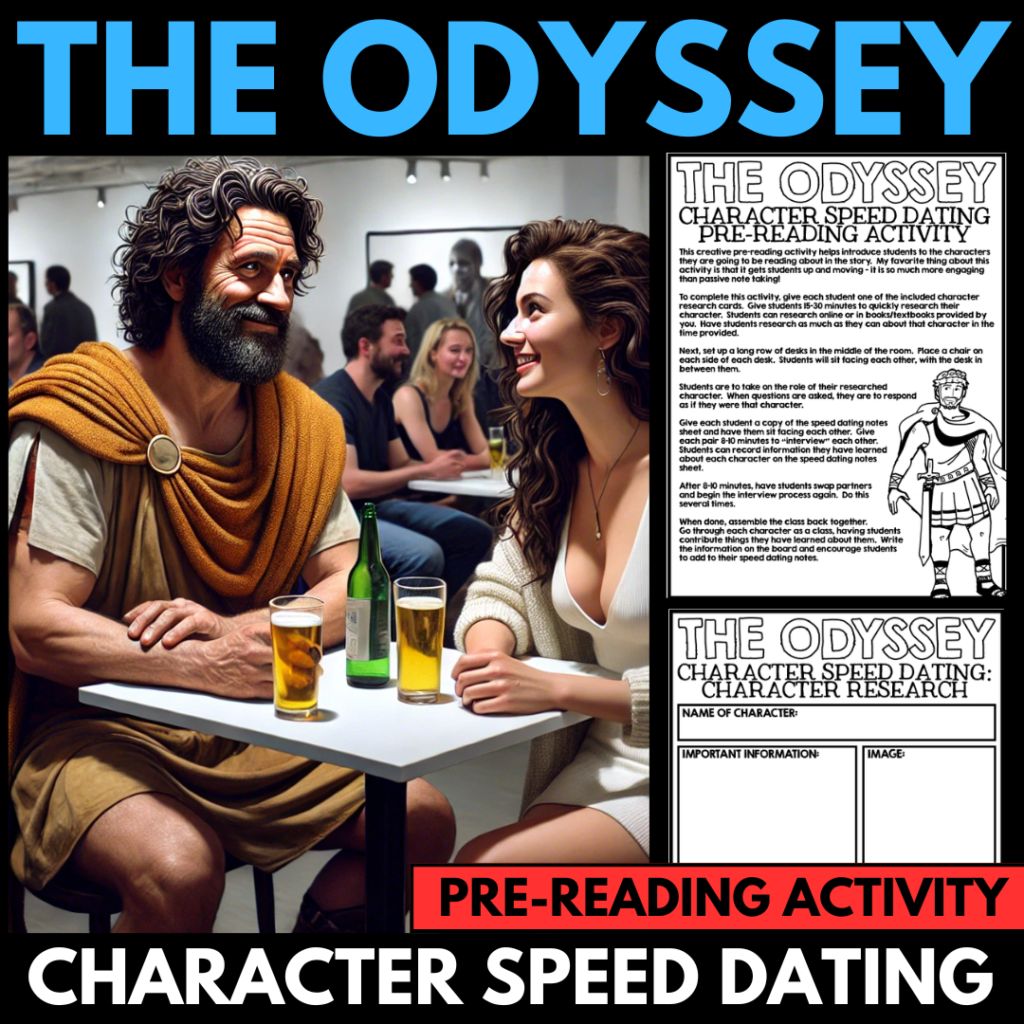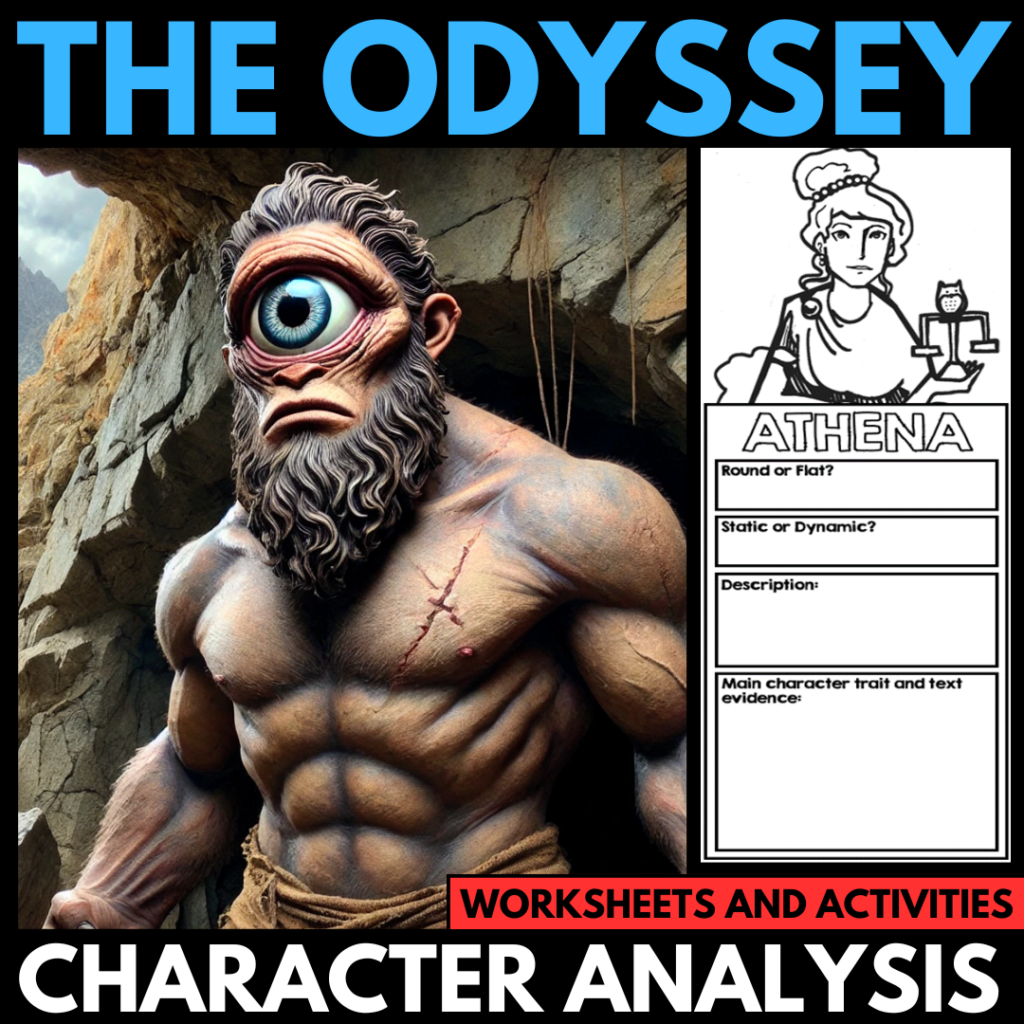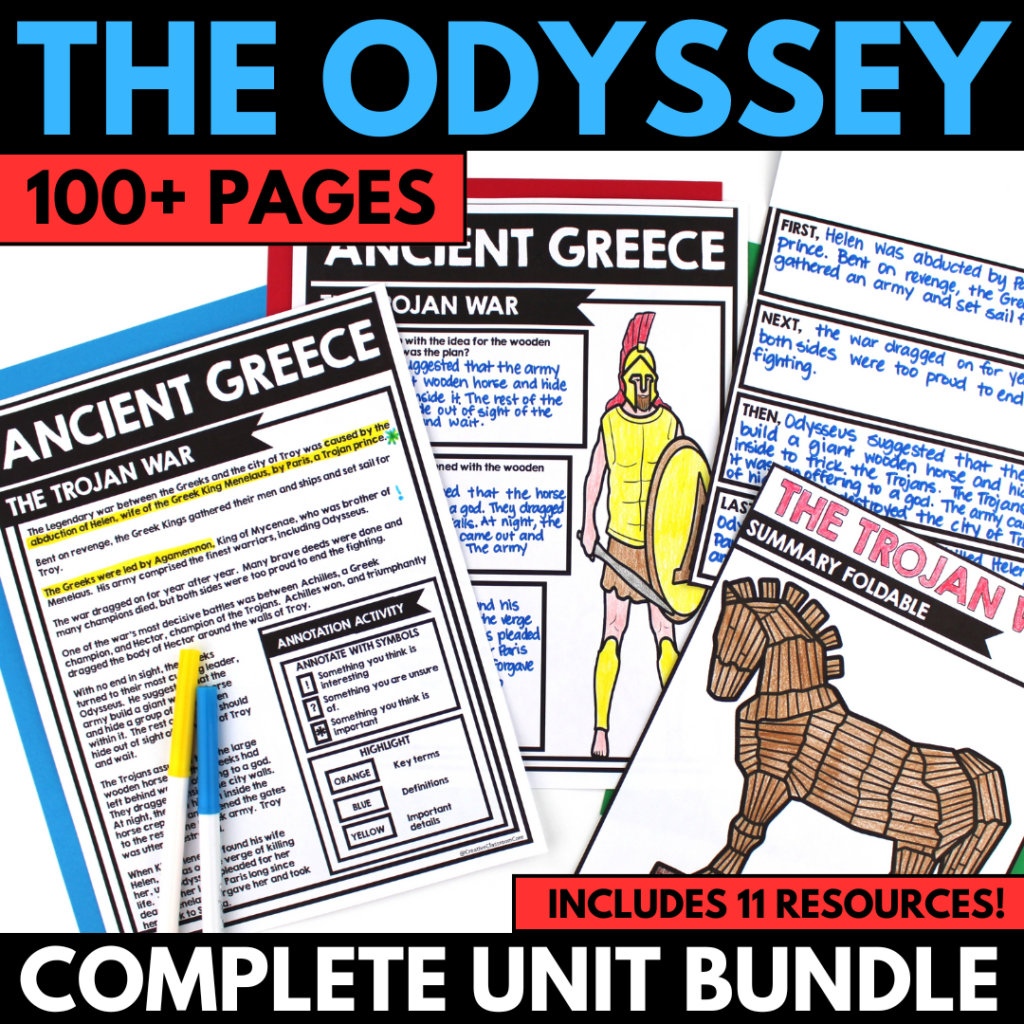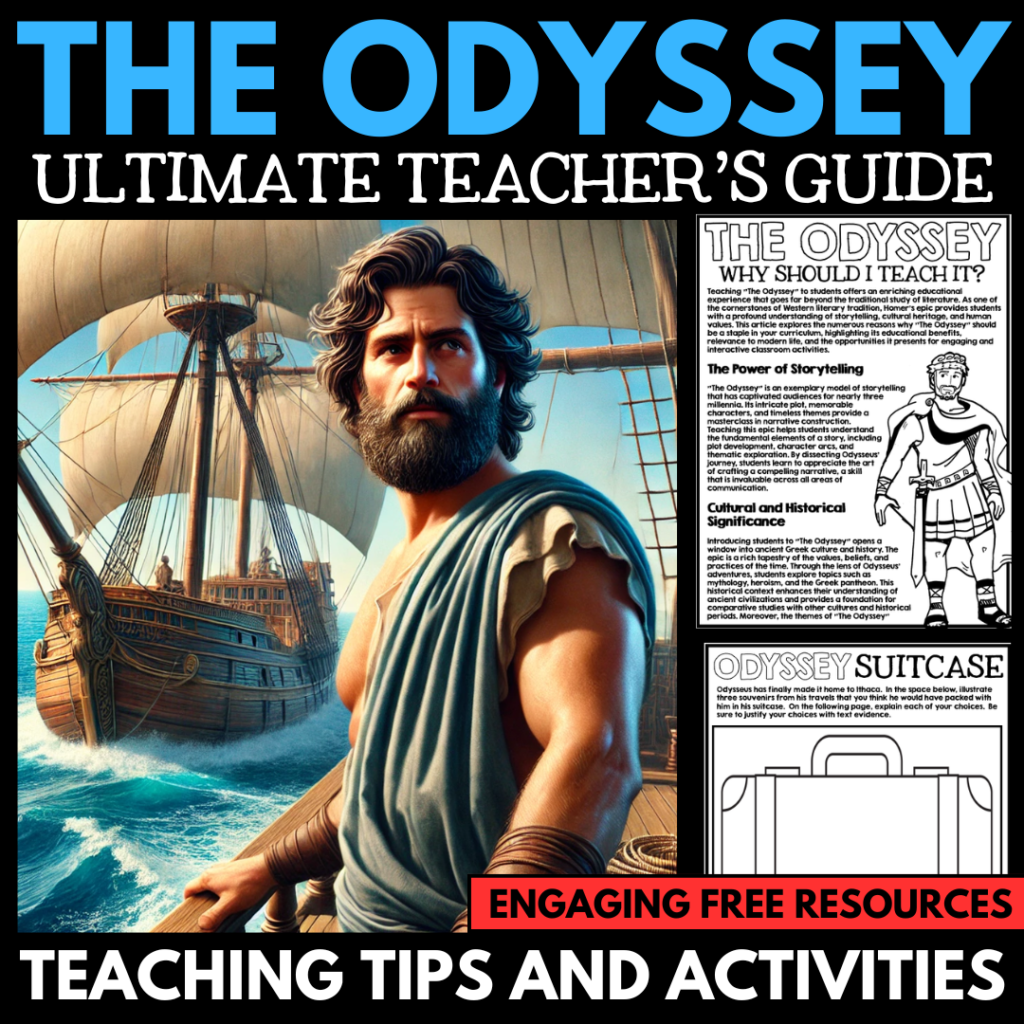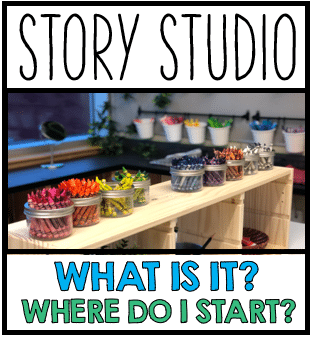Teaching Ideas for The Odyssey
“The Odyssey” to students in grades 4-9 offers an engaging educational experience that goes far beyond the traditional study of literature. As one of the cornerstones of Western literary tradition, Homer’s epic provides students with an understanding of storytelling, cultural heritage, and human values. I strongly believe that “The Odyssey” should be a staple in your curriculum, as it presents numerous opportunities for engaging and interactive classroom activities. Read on for some creative teaching ideas for The Odyssey.
Are you looking for some print-and-go resources and teaching ideas for The Odyssey? Click on the image or button below to see all of the teaching ideas for The Odyssey available in my TPT shop!
Why Should I Teach the Odyssey?
Curious about why you should teach this engaging epic in your classroom? Read on for some of my top reasons.
The Power of Storytelling
The Odyssey is an excellent model of storytelling that has drawn in audiences for nearly three millennia. Its intricate plot, memorable characters, and timeless themes make it the perfect story for student in grades 4-9. Teaching this epic helps students understand the fundamental elements of a story, including plot development, character arcs, and theme.
Cultural and Historical Significance
Introducing students to The Odyssey provides a clear view into ancient Greek culture and history. The epic showcases the values, beliefs, and practices of the time. Through Odysseus’ adventures, students explore mythology, heroism, and the Greek gods, deepening their understanding of ancient civilizations. This context not only enhances their knowledge of ancient Greece but also allows for comparisons with other cultures and historical periods. Additionally, the themes in The Odyssey resonate with universal human experiences, making the lessons from ancient Greece relevant and meaningful for students today.
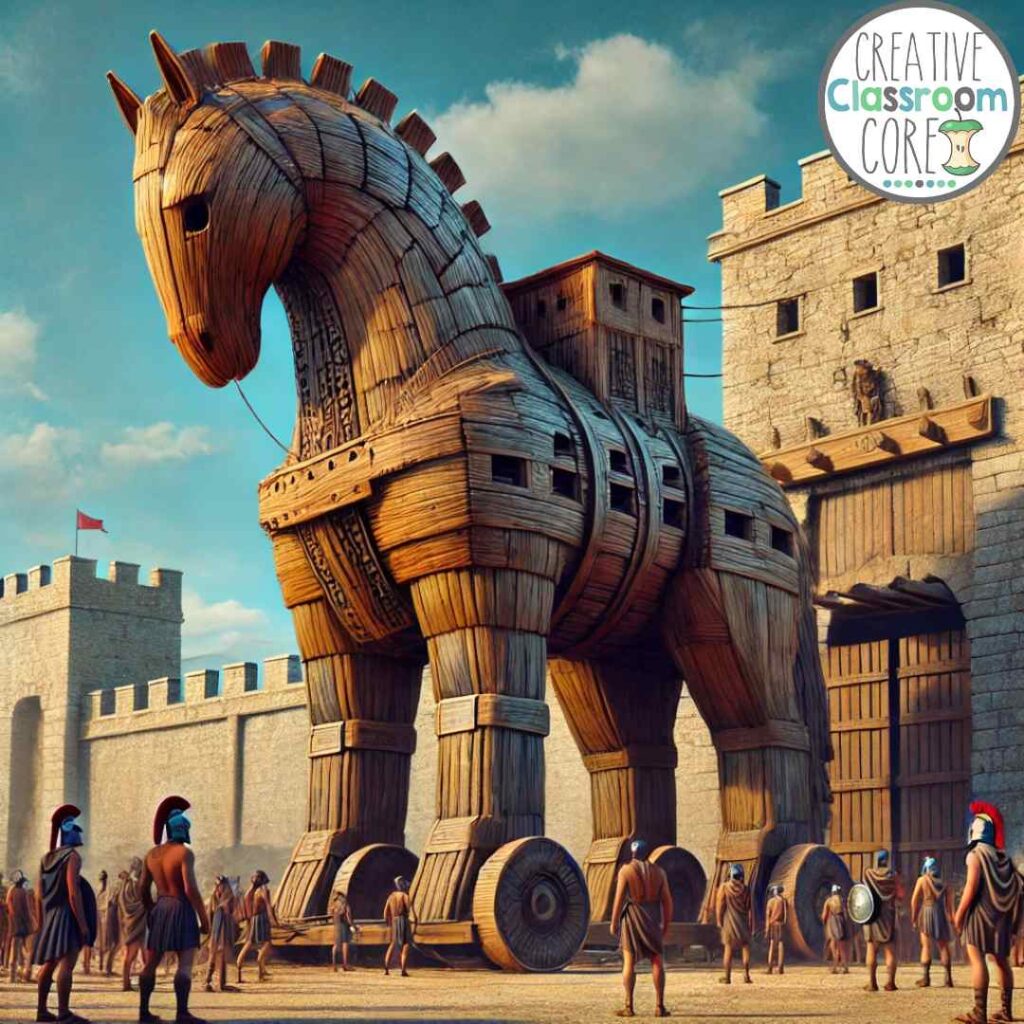
Developing Critical Thinking Skills
The Odyssey challenges students to think critically and analytically. The epic’s complex narrative structure, with its use of flashbacks and nonlinear storytelling, encourages students to piece together the story’s timeline and understand its deeper meanings. Analyzing the characters’ motivations, decisions, and growth throughout the epic fosters critical thinking and ethical reasoning. For example, discussions about Odysseus’ leadership qualities, his moral dilemmas, and his strategies for overcoming obstacles can lead to thoughtful debates and reflections on personal values and decision-making processes.
Themes of Perseverance and Resilience
One of my favorite reasons to teach The Odyssey is its exploration of perseverance and resilience. Odysseus’ long and arduous journey home, filled with trials and tribulations, serves as an inspiring metaphor for overcoming challenges. Students learn that determination, cleverness, and resilience are essential traits for achieving one’s goals. These lessons are particularly relevant for young learners who are developing their own coping strategies for life’s obstacles. By identifying with Odysseus’ struggles and triumphs, students gain a deeper understanding of their own potential for growth and success.
Enhancing Language and Literacy Skills
Studying The Odyssey significantly enhances students’ language and literacy skills. The epic’s rich and varied vocabulary introduces students to new words and expressions, improving their linguistic proficiency. Additionally, the poetic structure of the text, with its use of epithets, similes, and metaphors, provides a valuable opportunity to study literary devices in context. Engaging with the text through reading, writing, and discussion activities sharpens students’ comprehension and analytical skills, laying a strong foundation for future literary studies.
Encouraging Creative Expression
The Odyssey offers ample opportunities for creative expression in the classroom. Teachers can encourage students to reimagine parts of the story, create their own myths, or write diary entries from the perspectives of different characters. Art projects, such as drawing scenes from the epic or crafting models of Odysseus’ ship, allow students to express their understanding visually. Dramatic activities, such as reenacting key scenes or performing modern adaptations of the epic, make the story come alive and foster a deeper connection with the material.
Looking for additional ways to integrate art into your classroom lessons? Check out our guide to arts integration!

Relevance to Modern Life
Despite its ancient origins, The Odyssey remains highly relevant to modern life. The themes of the epic, such as the search for identity, the importance of family, and the struggle against adversity, are universal and timeless. By drawing parallels between Odysseus’ experiences and contemporary issues, teachers can help students see the relevance of classical literature in their own lives. For example, discussions about the challenges of returning home and reintegrating into society can resonate with students who have experienced significant life changes.
Cross-Curricular Connections
The Odyssey is a versatile text that lends itself to cross-curricular connections. Teachers can integrate lessons from history, geography, and social studies to provide a comprehensive understanding of the epic’s context. Science lessons can explore topics such as ancient navigation techniques and the natural phenomena described in the story. Art and music classes can delve into the artistic representations and musical adaptations of the epic. This interdisciplinary approach not only enriches students’ learning experiences but also highlights the interconnectedness of knowledge across different fields.
Building a Love for Classical Literature
Introducing students to The Odyssey at an early age helps cultivate a lifelong appreciation for classical literature. By making the epic accessible and engaging, teachers can spark students’ interest in exploring other works of ancient literature and mythology. This early exposure to the classics builds a strong foundation for more advanced literary studies in high school and beyond. Moreover, it fosters a sense of curiosity and wonder about the past, encouraging students to explore the rich heritage of human storytelling.
Teaching Ideas for the Odyssey
Looking for some fun teaching ideas for The Odyssey that you can incorporate into your classroom lessons? Check out these fun ideas!
Pre-Reading Activity – Character Speed Dating
This fun and interactive activity is one of my favorite teaching ideas for The Odyssey, and is the perfect way to introduce students to the key characters while getting them up and moving. Students research assigned characters and take on their roles, then participate in a speed-dating style interview session where they gather information about each character. To help keep everything straight, students can use the provided note-taking templates to jot down important details about each character they meet. This memorable pre-reading activity sets a solid foundation for their journey through The Odyssey!
Grab a copy of this engaging resource below by clicking on the image or button!
Unit Introduction – Character and Setting Notes
This literature packet includes multiple pages of detailed character and setting notes, ensuring students grasp key facts and important details about the epic’s complex world. Additionally, a fun matching activity is included to reinforce their understanding.
With numerous characters and locations in The Odyssey, students might find it challenging to keep track of everything. Our note-taking templates allow students to jot down essential details from the provided information sheets, making it easy to refer back when needed. This resource is invaluable for helping students review and study, ensuring they stay organized and confident throughout the unit.
Download a copy of this resource by clicking on the image or button below!
Character Analysis Activities
These teaching ideas for The Odyssey are essential for any Odyssey unit, promoting increased comprehension and understanding by encouraging students to thoroughly analyze important characters. The worksheets cover nine significant figures from the epic, including Odysseus, Penelope, Telemachus, Polyphemus, Circe, Calypso, Athena, The Sirens, and Poseidon.
By completing these character analysis activities, students will gain deeper insights into the motivations, relationships, and developments of each character, enhancing their overall grasp of the text.
Grab a copy to use with your learners by clicking on the image or button below.
For more information on character analysis, check out our complete guide!
Looking for more Teaching Ideas for The Odyssey?
Click on the image or button below to download the complete unit bundle – it contains over 100 pages of resources and activities!
Looking for Some Free Resources to Help You Plan?
Click on the image or button below to download out FREE GUIDE to teaching The Odyssey!
Interested in signing up for my email list?
If you are interested in signing up for my email list, you can do so by clicking on the link below. I periodically send out emails with free resources, teaching tips, and exclusive deals. Signing up will also give you immediate access to some of my best selling Interactive Notebook resources – foldables, graphic organizers, and other fun activities.
